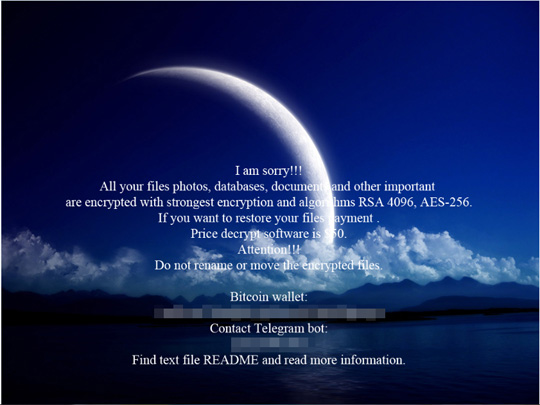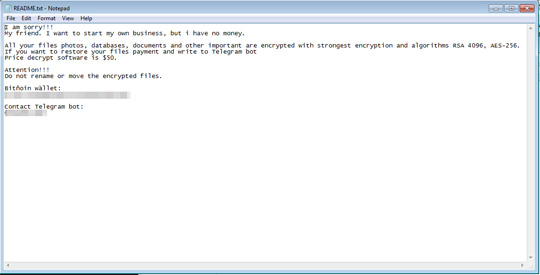Ransom.Win32.IMSORRY.THGAGAIA
Windows


Threat Type: Ransomware
Destructiveness: No
Encrypted:
In the wild: Yes
OVERVIEW
This Ransomware arrives on a system as a file dropped by other malware or as a file downloaded unknowingly by users when visiting malicious sites.
It encrypts files found in specific folders. It drops files as ransom note.
TECHNICAL DETAILS
Arrival Details
This Ransomware arrives on a system as a file dropped by other malware or as a file downloaded unknowingly by users when visiting malicious sites.
Installation
This Ransomware adds the following processes:
- %ApplicationData%\desk.bat
- reg add "HKCU\control panel\desktop" /v wallpaper /t REG_SZ /d "" /f ;
- reg add "HKCU\control panel\desktop" /v wallpaper /t REG_SZ /d "%ApplicationData%\des1.jpg" /f ;
- reg delete "HKCU\Software\Microsoft\Internet Explorer\Desktop\General" /v WallpaperStyle /f;
- reg add "HKCU\control panel\desktop" /v WallpaperStyle /t REG_SZ /d 2 /f;
- RUNDLL32.EXE user32.dll,UpdatePerUserSystemParameters ;
- vssadmin.exe Delete Shadows /All /Quiet;
- sc stop VVS;
- sc stop wscsvc;
- sc stop WinDefend;
- sc stop wuauserv;
- sc stop BITS;
- sc stop ERSvc;
- sc stop WerSvc;
- bcdedit /set {default} recoveryenabled No;
- bcdedit /set {default} bootstatuspolicy ignoreallfailures;
- vssadmin.exe Delete Shadows /All /Quiet;
- %Application Data%\svchost .exe
(Note: %Application Data% is the current user's Application Data folder, which is usually C:\Documents and Settings\{user name}\Application Data on Windows 2000(32-bit), XP, and Server 2003(32-bit), or C:\Users\{user name}\AppData\Roaming on Windows Vista, 7, 8, 8.1, 2008(64-bit), 2012(64-bit) and 10(64-bit).)
Other System Modifications
This Ransomware modifies the following registry entries:
HKEY_CURRENT_USER\Control Panel\Desktop
WallpaperStyle = 2
It changes the desktop wallpaper by modifying the following registry entries:
HKEY_CURRENT_USER\Control Panel\Desktop
wallpaper = %ApplicationData%\des1.jpg
Dropping Routine
This Ransomware drops the following files:
- %Application Data%\desk.bat
- %Application Data%\des1
- %Application Data%\svchost .exe
(Note: %Application Data% is the current user's Application Data folder, which is usually C:\Documents and Settings\{user name}\Application Data on Windows 2000(32-bit), XP, and Server 2003(32-bit), or C:\Users\{user name}\AppData\Roaming on Windows Vista, 7, 8, 8.1, 2008(64-bit), 2012(64-bit) and 10(64-bit).)
Other Details
This Ransomware encrypts files with the following extensions:
- .odt
- .ods
- .odp
- .odm
- .ode
- .odb
- .doc
- .docx
- .docm
- .wps
- .xls
- .xlsx
- .xlsm
- .xlsb
- .xlk
- .ppt
- .pptx
- .pptm
- .mdb
- .accdb
- .pst
- .dwg
- .dxf
- .dxg
- .wpd
- .rtf
- .pcx
- .wb2
- .mdf
- .dbf
- .psd
- .pdd
- .djvu
- .jpg
- .c
- .cpp
- .txt
- .jpeg
- .png
- .gif
- .bmp
- .mp3
- .apk
- .zip
- .aspx
- .php
- .sqlite3
- .rar
- .eps
- .ai.indd
- .cdr
- .dng
- .3fr
- .arw
- .srf
- .sr2
- .bay
- .crw
- .cr2
- .dcr
- .kdc
- .erf
- .mef
- .mrwref
- .nrw
- .orf
- .raf
- .raw
- .rwl
- .rw2
- .r3d
- .ptx
- .pef
- .srw
- .x3f
- .der
- .cer
- .crt
- .pem
- .pfx
- .p12
- .p7b
- .p7c
- .html
- .css
- .js
- .sql
- .mp4
- .flv
- .m3u
- .py
- .desc
- .con
- .htm
- .bin
- .wotreplay
- .unity3d
- .big
- .pak
- .rgss3a
- .epk
- .bik
- .slm
- .lbf
- .sav
- .lng
- .ttarch2
- .mpq
- .re4
- .bsa
- .cab
- .ltx
- .forge
- .asset
- .hkx
- .DayZProfile
- .dbO
- .mpqge
- .vfsO
- .mcmeta
- .m2
- .lrf
- .vpp_pc
- .ff
- .cfr
- .snx
- .lvl
- .arch00
- .ntl
- .fsh
- .w3x
- .rim
- .psk
- .tor
- .vpk
- .iwd
- .kf
- .mix
- .fpk
- .vtf
- .001
- .esm
- .blob
- .dmp
- .layout
- .menu
- .ncf
- .sid
- .sis
- .vdf
- .mcgame
- .fos
- .sb
- .im
- .wmo
- .itni
- .map
- .svg
- .cas
- .gho
- .iso
- .ncdb
- .mdbackup
- .hkdb
- .hplg
- .hvpl
- .icxs
- .itdb
- .itl
- .mddata
- .sidd
- .sidn
- .bkf
- .qic
- .bkp
- .bc7
- .bc6
- .pkpass
- .tax
- .gdb
- .qdf
- .tl2.tl3
- .ibank
- .sum
- .sie
- .sc2save
- .d3dbsp
- .wmv
- .avi
- .wma
- .m4a
- .7z
- .torrent
- .csv
- .cs
- .jar
- .java
- .class
- .wav
- .asp
- .sqlitedb
- .w
Ransomware Routine
This Ransomware encrypts files found in the following folders:
- C:\
It avoids encrypting files found in the following folders:
- Default
- All Users
- Content
- IE5
- Temporary Internet Files
- Local Settings
- AppData
- Program Files (x86)
- Program Files
- Windows
- Microsoft
- Program Data
- ProgramData
- Intel
- $Recycle.Bin
It appends the following extension to the file name of the encrypted files:
- .ch4x0 - only appends during encryption process and remove it after
It drops the following file(s) as ransom note:
- Drops a ransom note
%Desktop%\README
SOLUTION
Step 1
Before doing any scans, Windows 7, Windows 8, Windows 8.1, and Windows 10 users must disable System Restore to allow full scanning of their computers.
Step 2
Identify and terminate files detected as Ransom.Win32.IMSORRY.THGAGAIA
- Windows Task Manager may not display all running processes. In this case, please use a third-party process viewer, preferably Process Explorer, to terminate the malware/grayware/spyware file. You may download the said tool here.
- If the detected file is displayed in either Windows Task Manager or Process Explorer but you cannot delete it, restart your computer in safe mode. To do this, refer to this link for the complete steps.
- If the detected file is not displayed in either Windows Task Manager or Process Explorer, continue doing the next steps.
Step 3
Search and delete these components
- %Application Data%\desk.bat
- %Application Data%\des1
- %Desktop%\README
- %Application Data%\svchost .exe
Step 4
Reset your Desktop properties
Step 5
Scan your computer with your Trend Micro product to delete files detected as Ransom.Win32.IMSORRY.THGAGAIA. If the detected files have already been cleaned, deleted, or quarantined by your Trend Micro product, no further step is required. You may opt to simply delete the quarantined files. Please check the following Trend Micro Support pages for more information:
Step 6
Restore encrypted files from backup.
Did this description help? Tell us how we did.

